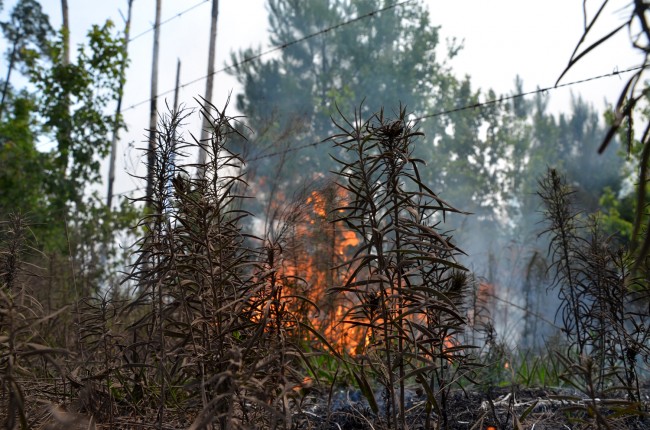
The Espanola fire had a break-out today beyond its fire lines and grew to 4,171 acres by afternoon, according to a Florida Division of Forestry official, a difference of about 1,000 acres from the figure reported by officials Monday morning. The afternoon’s thunderstorms dumped rain on Palm Coast and lightning strikes elsewhere, likely starting new fires that have yet to be detected.
Greg Dunn, the county forester for Flagler County and a senior forester with the Florida Division of Forestry, said the Espanola fire “made a run outside the lines, but firefighters were able to contain” the breakout, while other parts of the fire are burning inside the lines. Some 138 people are working the Espanola fire, including one of the two 12-member strike teams dispatched from Virginia and Mississippi. The second is scheduled to arrive on Tuesday.
Click On:
- Jacksonville and Clay Exit, Va. and Miss. Send Help As Espanola Fire Grows to 3,800 Acres
- Video Tour: Lt. Richard Bennett Takes You Into the Heart of the Espanola Fire
- At Second Chance Rescue Near Espanola Fire, 100 Animals Are Prepared for Evacuation
On Monday, smoke coated Palm Coast as winds shifted. Sunday’s lightning storm started four small fires. Those were found and contained, according to Don Petito, Flagler County’s fire chief.
“Over the next couple of days we’ll be concentrating on reconnaissance of the area to make sure that there are no other fires created by that lightning storm,” Petito said. “That’s one of our major concerns, the afternoon thunderstorms that keep popping up, creating more fires. That’s what’s going to stress the resources.”
The Sunday thunderstorm was similar to Monday’s, producing—in the areas of the fire, anyway—little rain and plenty of lightning. “Our expectation,” Marty Senterfitt, a member of the state’s Incident Management Team, or Gray Team, that’s been coordinating responses to the Flagler fires, “is every day we’re going to find new fires after these thunderstorms go through and we’ve just got to stay ahead of it. To put it in context for the community though, what we have seen is a little bit of a drop in our mutual aid capabilities from other counties, and it’s not because for lack of caring. The simple reality is, fires are popping up all around us right now. Even some of my team, the gray team, are being pulled off as we speak to go fight fires in their home communities, and it’s starting to just become a real problem throughout northeast Florida and really in Florida as a whole.”
The Gray Team is being replaced by the Division of Forestry’s Red Team, whose firefighters are deployed at the Espanola fire while its command structure is deploying at the county’s Emergency Operations Center.
Daniel Stanley, a liaison officer with the Division of Forestry, explained how fire acreage may seesaw at times, as it has recently around the Espanola fire. Sunday, for example, Petito put the fire’s acreage at 3,800 acres. That was revised to “3,000-acres plus” by Monday morning—and raised again by late Monday.
“You may see that figure go down. Sometimes that happens due to better GIS mapping, we can actually cut some pockets off from what we originally estimate,” Stanley said. “There’s a lot of times smoke’s laying down over it, we can’t get an accurate picture, so sometimes it may go up or down, when a fire is that big it’s an estimate until you can get a very precise number on that.”
The 1998 and 1985 fires have been on firefighting officials’ minds lately, particularly due to the potential for complacency, when a lull appears to take the attention away from the fires. That happened in 1998. At the time, the first major fire broke out on June 7. But there was a two-week lull. The second wave was more devastating. Those fires eventually burned 70 homes, including 19 in the Seminole Woods area, back when the density of construction was almost half what it is today. In 1985, when the density was even lighter, the fires burned 135 homes. But the county’s preparedness was not then what it is today.
And Stanley said conditions today are “just not quite as dray as it was in 1998.” But every day without heavy rains, the conditions get dryer. And the hotter the weather, the more primed the fuel on the ground is to burn.
“We had a really good day, we got a lot accomplished in the last couple of days.” But there was no rain on the White Eagle fire. “We listened to everybody else getting rained.”




























palmcoaster says
Thanks to FlaglerLive for all these fires update.
The Truth says
Yes, thank you to FlaglerLive for providing updates. I visit FlaglerEmergency every day and I’m lucky if that site is even updated.